|
Displaying items by tag: commissioned
The most sumptuous moment in America's Gilded Age is revealed through the work of some of its most noted design firms in Artistic Furniture of the Gilded Age at The Metropolitan Museum of Art. The centerpiece of the three-part exhibition is the opulent Worsham-Rockefeller Dressing Room from the New York City house commissioned by art collector and philanthropist Arabella Worsham (later Huntington; ca. 1850-1924).
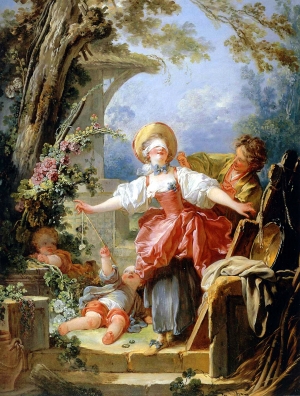
Two erotically charged works by the French painter Jean-Honoré Fragonard have been reunited at the Toledo Museum of Art for the first time in 25 years. ‘Blind Man’s Buff’ and ‘The See-Saw’ are the centerpieces of the exhibition ‘Love and Play: A Pair of Paintings by Fragonard,’ which is the first show in the museum’s ENCOUNTERS series that pairs exceptional works of art in new and inventive ways.
‘Blind Man’s Buff,’ which is part of the Toledo Museum’s collection, and ‘The See-Saw,’ which is on loan from the Thyssen-Bornemisza Museum in Madrid, were painted in Paris during the early 1750s and were most likely commissioned by Baron Baillet de Saint-Julien. The works passed through a number of private collections until they appeared on the market in 1954 and were ultimately separated. The companion paintings were reunited several times for temporary exhibitions in 1968, 1987 and 1988. In addition to the paintings, the Toledo Museum’s exhibition will include two engraved copies of the canvases, a Rococo terracotta sculpture by the French sculptor Clodion, and a small selection of French decorative arts.
Fragonard was one of the most celebrated artists of the 18th-century Rococo era of French painting and was known for his risque depictions of love and courtship. ‘Blind Man’s Buff’ and ‘The See-Saw’ epitomize the exuberance and hedonism that attracted Fragonard’s patrons.
‘Love and Play’ will be on view at the Toledo Museum through May 4, 2014.
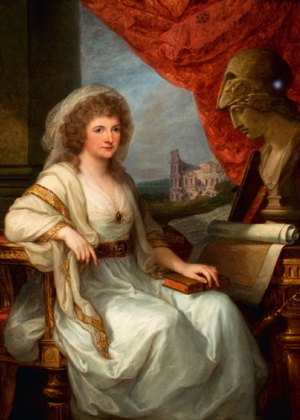
An 18th century portrait of the German Duchess Anna Amalia of Saxe-Weimar-Eisenach commissioned by the German writer Johann Wolfgang von Goethe has been returned to its rightful heirs after 70 years. The oil painting by Angelika Kauffmann went missing from the duchess’ descendants’ palace in Poland during World War II. The work did not resurface until 2011 when a Polish consignor brought the work to Sotheby’s.
The painting was returned to the city of Weimar during a ceremony at the Weimar palace. Michael Saxe-Weimar-Eisenach, the heir of the painting, has decided to loan the work to the city permanently. Upon its completion, the work, which is said to be worth hundred of thousands of euros, hung in the Roman House in Weimar, which was also commissioned by Goethe. The painting was later moved to the palace in Weimar and then to a family residence in Silesia, which is now part of Poland.
A Sotheby’s employee in London was the first to spot the painting on a German database for lost art. After reporting its reappearance to Weimar city officials, Sotheby’s held on to the painting until an agreement was reached. An exhibition of the work at the Roman House is being planned for next year.
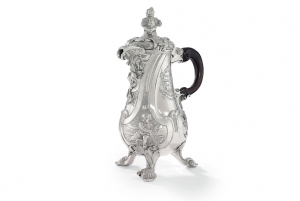
Christie’s London will offer a Rococo coffee-pot by Paul de Lamerie (1688-1751), the most celebrated British silversmith of the 18th century, as part of its Exceptional Sale on July 4, 2013. The George II silver coffee-pot, which was commissioned in 1738 by a wealthy London-based merchant, is expected to become the most valuable piece of English silver ever to be sold at auction. The masterpiece was recently the highlight of a British silver exhibition at the Metropolitan Museum of Art in New York.
Lamerie, who began his career in 1703 as an apprentice to the London goldsmith, Pierre Platel (1659-1739), opened his own workshop in 1713 and was soon appointed goldsmith to George I. His work evolved from simple Queen Anne styles to classical French designs, but his ornate Rococo works of the 1730s are his most admired pieces. Lamerie’s illustrious clientele included Sir Robert Walpole, King John V of Portugal, and Queen Elizabeth II, who he made a wedding gift for.
The coffee-pot heading to auction in July is expected to garner approximately $4.5 million.

Sotheby’s will present three early bronzes from Auguste Rodin’s (1840-1917) pivotal The Gates of Hell at its Impressionist and Modern Art Evening Sale on May 7, 2013 in New York. The three casts are part of a renowned private collection and include a rare, early cast of The Thinker (1906), which is expected to garner anywhere from $8 million to $12 million.
The cast of The Thinker was made by the Alexis Rudier foundry in Paris and was commissioned directly from the artist by the publishing tycoon, Ralph Pulitzer. The sculpture features a plaque stating that it was made for Pulitzer under Rodin’s immediate supervision. The other casts included in the Impressionist and Modern Art auction are Rodin’s beloved The Kiss (1909) and Ugolino and His Children (1883), which was only cast three times during Rodin’s lifetime.
The Directorate of Fine Arts commissioned The Gates of Hell, which was inspired by Dante Alighieri’s The Divine Comedy, in 1880. The project was originally expected to take five years but Rodin spent 37 years working intermittently on what would become the defining sculpture of his career. While The Gates of Hell was never fully realized, many of Rodin’s most notable sculptures are related to the single and multi-figure works he created for the commission.
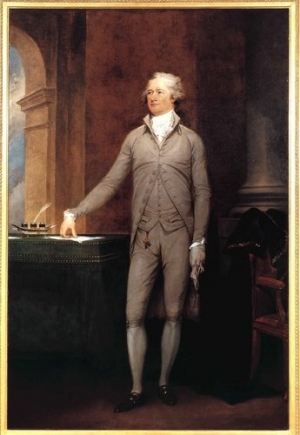
The international financial services group, Credit Suisse, has decided to donate a portrait of Alexander Hamilton by Revolution-era painter, John Trumbull (1756-1843), to not one, but two museums. The painting has been on loan to the Crystal Bridges Museum of American Art in Bentonville, Arkansas since it opened to the public in 2011.
Credit Suisse decided that giving the portrait to Crystal Bridges and the Metropolitan Museum of Art in New York, two well-known institutions, would maximize the public’s enjoyment of the work by expanding its audience. The shared ownership will see that the portrait remains in Arkansas until the summer, when it will travel to the Met for a year. The painting will return to Crystal Bridges in 2014 for another year. Eventually the painting will be on view at each museum for two-year stretches.
Credit Suisse acquired the striking full-length portrait in 2000 when it absorbed the New York-based investment bank Donaldson, Lufkin & Jenrette. Richard Jenrette, one of the bank’s founding partners, had assembled a remarkable art collection for the company that became part of Credit Suisse’s acquisition.
The New York Chamber of Commerce commissioned Trumbull to paint the Hamilton portrait in 1791 while he was serving as President Washington’s Secretary of the Treasury.
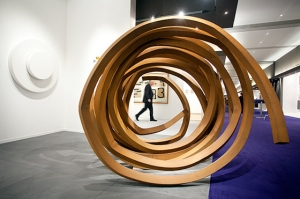
China’s art market experienced a substantial boom in 2011, bumping the United States out of its top spot and ultimately becoming the world’s principal market for art and antiques. In 2012, amid the uncertain global economy, China’s growth began to slow and its art and antiques market shrank by almost a quarter. This deceleration allowed the U.S. to regain its title as the world’s most significant art market.
The power shift was announced as part of the highly anticipated TEFAF Art Market Report compiled by Dr. Clare McAndrew. McAndrew, a cultural economist who specializes in the fine and decorative art market, is the founder of Arts Economics, a company commissioned by The European Fine Art Foundation to provide a yearly analysis of the worldwide art market. The report coincides with the beginning of TEFAF Maastricht, the Foundation’s annual art fair, which begins March 15, 2013 in the Netherlands and runs through March 24, 2013.
Slowing economic growth and a lack of high quality, high priced items on the market are to blame for China’s slip to the second most influential art market. While auction sales dropped by 30% in China, U.S. sale figures were up 5% to $18.4 billion. In 2012, buyers opted to minimize financial risk by buying works by well-known artists at the top end of the market with Post-War and Contemporary art performing the strongest.
Dr. McAndrew will present her findings at the TEFAF Art Symposium on Friday, March 15, 2013 in Maastricht.
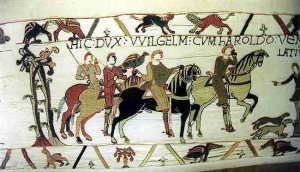
Residents of Alderney, the northernmost of the British Channel islands, recently came together to complete the Bayeux tapestry, an embroidered cloth measuring 230 feet from the 1070s. The original tapestry is believed to have been commissioned by Bishop Odo of Bayeux, the half brother of Duke William II of Normandy, and was sewn by English needle-works in either Winchester or Canterbury over a ten year span.
The Bayeux Tapestry is comprised of 50 scenes depicting the events leading up to the Norman conquest of England at the Battle of Hastings, where Duke William II defeated King Harold II of England. However, the tapestry ends before the coronation of William in London in 1066, leading experts to believe that the embroidery had lost its final panels over the centuries.
Hundred of people from Alderney have contributed to the completion of the Bayeux tapestry. Designed by artist Pauline Black, the project was overseen by Kate Russell, an American who lives on the island. Prince Charles and Camilla Parker Bowles even added a few stitches while on a visit to the Channel Islands.
The completed Bayeux tapestry will go on display at the Alderney Museum later this year.
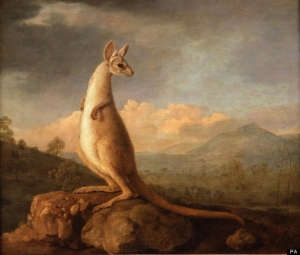
The British government has placed a temporary export bar on two important oil paintings by George Stubbs (1724-1806), an English painter best know for his depictions of horses. The works, which went on display at London’s Royal Academy in 1773, gave the British public their first glimpse of a kangaroo and a dingo.
Since Stubbs was unable to paint the animals, which are native to Australia, from life, he created Kongouro from New Holland (The Kangaroo) (1772) and Portrait of a Large Dog (The Dingo) (1772) from spoken accounts. He also made sketches of the kangaroo after inflating the animal’s preserved skin. Stubbs won praise for bringing the likenesses of the foreign animals to the British public for the first time. It is believed that Sir Joseph Banks commissioned the paintings after assisting in Captain James Cook’s first voyage to the Pacific.
Culture Minister Ed Vaizey announced the temporary export bar on Wednesday, February 6, 2013 following a recommendation by the Reviewing Committee On The Export of Works of Art and Objects of Cultural Interest. The ban will remain in place until August 5, 2013 and may be extended until November 5, 2013. Potential buyers will need $8.6 million to keep the paintings in Britain.
|
|
|
|
|